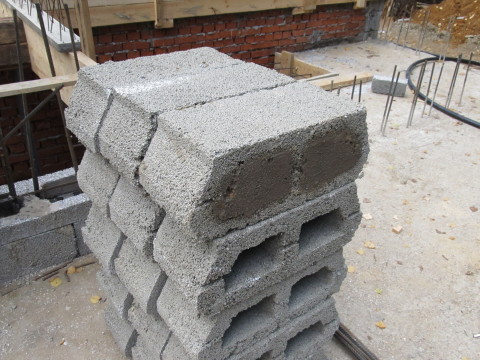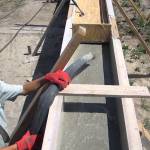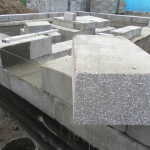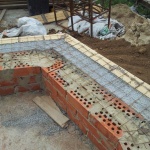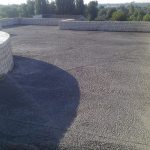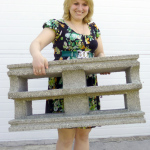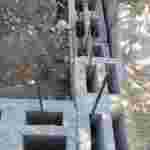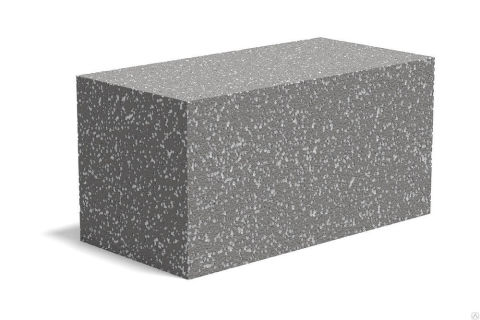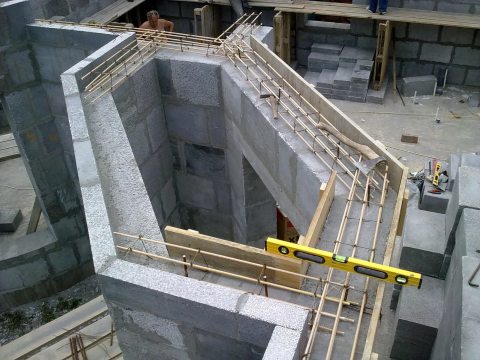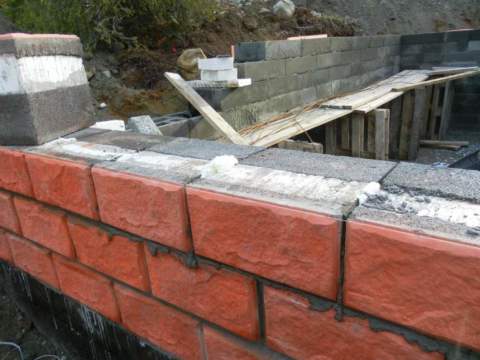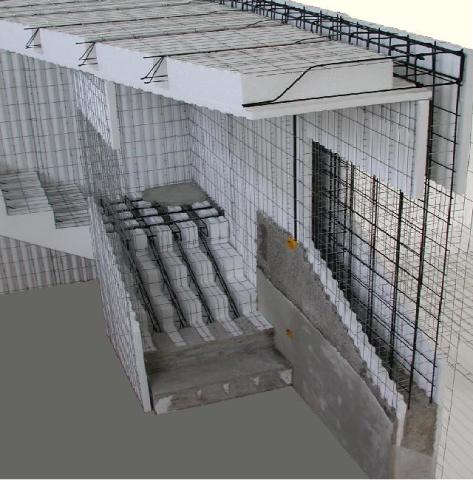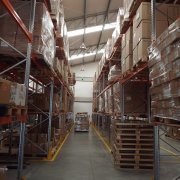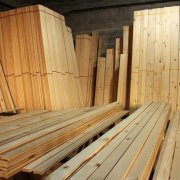Tandem of polystyrene and concrete: what technologies will say a weighty word in construction?
Analyzing the costs of a communal apartment, each of us understands that their lion's share is the cost of maintaining heat in the house. Therefore, the main task of modern construction is to reduce them, which can only be achieved by improving the heating technology of the walls. The creators of new heat-insulating materials set themselves the following goals: they should be made from accessible raw materials, using the most simplified technologies, and at the same time their efficiency should be an order of magnitude higher than that of old-generation materials.
Only under such conditions, the novelty becomes competitive, and can join the ranks of the options already presented on the construction market. One of the materials that meet these requirements was the composite of an existing insulation, which is polystyrene foam, and cement stone. It was called “polystyrene concrete” - and we would like to draw the attention of the reader to it.
The content of the article
Creation and improvement of material
The main advantage of polystyrene concrete can be considered the fact that it is not just a heater, but also a structural material. The purpose of creating any composite is to obtain characteristics that carry all the best qualities of the materials to be combined. In this case, it has the strength of concrete and the thermal conductivity of polystyrene, which provides it with its own special niche in the building materials market.
Simply put, you can build a house from polystyrene concrete - and not only build walls, but also complete all other structures. At the same time, the costs will be less, and the house will be much warmer.
A bit of history
In general, polystyrene concrete, as such, was invented back in the middle of the last century by a German scientist named Fritz Stestni. Then the material turned out to be expensive, and paved its way with considerable difficulty. But gradually it was recognized not only in Western Europe, but also in Canada and America. He came to us closer to the end of the 90s - in any case, the first standard for polystyrene concrete was developed only in 1999.
According to this document, it could be used only for monolithic insulation of attics and roofs, for sealing concrete wall panels, and also as a filler for well masonry built of bricks. In 2012, a new edition of this standard was developed, in which this material is already positioned not only as a heat-insulating material, but as a structural one.
Key Applications
To be precise, in addition to purely heat-insulating polystyrene concrete, there are heat-insulating and structural, and structural and heat-insulating options.
Note! The difference between them is this. Polystyrene-filled concrete, the combined name of which begins with the word “heat-insulating,” can be used to make blocks, lintels and monolithic structures for curtain walls of buildings up to 25 floors high. If this is a structural and heat-insulating option, then it can be used already for the bearing walls of low-rise buildings, which, in fact, are private houses.
And yet, hollow ceilings are made from structural polystyrene concrete today: both solid and assembled from individual elements, which you can see in the header photo. Their main advantage is low weight.Use such ceilings for installation on walls made of lightweight concrete, which simply can not withstand the load from heavy reinforced concrete slabs.
- Monolithic erection of walls made of polystyrene concrete
- Construction of a house from structural and heat-insulating blocks
- Filling the wells of brick walls with polystyrene concrete
- Application of heat-insulating PSB: flat roof with monolithic insulation
- In a relatively short time, polystyrene concrete is recognized as one of the most promising materials of the future. The technology of its production, as well as the equipment used for this purpose, is constantly being improved, which greatly contributes to an increase in demand for such products.
- Concrete products of this type have several advantages - if you compare them with other options. Despite the fact that concrete with polystyrene filling has a lower density than heavy concrete, it has excellent strength, improved moisture resistance and frost resistance, as well as resistance to biological and chemical influences.
- In addition, the structures have the best heat engineering and sound insulation properties. It is also important that all these indicators are stable, and do not change, for example, in foam concrete, depending on the type of foaming agent.
The “cherry” on this “cake” is the relatively low cost of polystyrene concrete, which equally attracts private developers and representatives of small and medium-sized businesses.
Products from polystyrene concrete
If we talk about the construction of walls, then here are the most interesting three options for products made of polystyrene concrete. These are: hole blocks - the so-called fixed formwork, which allows you to build low-rise buildings in a precast-monolithic way; heat blocks having a finished facade surface; and three-layer panels (3D), used today in the construction of multi-storey frame houses.
Blocks as fixed formwork
The very idea of using concrete blocks as permanent formwork is not new. And we have been using it for at least three decades. The first were UDB blocks (perforated, universal), which are made of heavy concrete, with internal reinforcement. They are used where it is required to achieve the maximum strength of foundations and walls, which are obtained seismically stable.
- But as you know, reinforced concrete has the highest coefficient of thermal conductivity, so such walls require considerable costs for insulation. Therefore, for the construction of residential buildings, this is not the best option.
- The appearance of similar polystyrene concrete blocks, first of all, solved the problem of thermophysical characteristics of structures. Of course, in terms of strength, they still cannot compete with UDB, but in low-rise construction, the margin of safety that they have is quite enough.
- After all, the technology for the construction of prefabricated monolithic walls involves filling the vertical masonry channels with reinforcement and concrete, which, in fact, will absorb operational loads. For polystyrene concrete formwork, a completely different task is defined here: it will elementarily serve as insulation, insulating walls both outside and inside.
- Light weight of the blocks facilitates their installation
- Production of a strip foundation for a private house from polystyrene concrete blocks
- Formwork from pure polystyrene for concrete pouring Formwork from pure polystyrene for concrete pouring
- Among the innovative ideas also applies the use of fixed formwork made of ordinary polystyrene (without concrete). However, she did not find such popularity as an option made of polystyrene concrete. What is the reason for this? The fact is that with the use of such formwork there are some difficulties.
- Firstly, polystyrene blocks can only be laid on a finished concrete base. In contrast, PSB blocks can begin to be mounted on tamped soil, which we see in one of the above photos.
- Secondly, the formwork made of pure polystyrene is not so rigid. Everyone knows that polystyrene - and this is low density polystyrene, the material is quite fragile.
- It happened that the formwork could not withstand the pressure of concrete, and it simply spilled. And this is direct losses, since in such a situation it is necessary to redo the entire section of the wall. In addition, polystyrene granules are distributed throughout the object, and interfere with work.
There is also a third serious drawback of foam formwork. The fact is that this material is combustible, and therefore the walls built from it will constitute an element of increased risk of fire. But the polystyrene concrete formwork is devoid of all these shortcomings, since here the filler granules are connected by cement mortar.
Heat blocks and panels
From PSB also produce wall material of small and large format. There is a regular cast block; there is a heat block inside which there is a layer of pure polystyrene, and there are the same three-layer large-format panels that are hung on a reinforced concrete frame, and are used for the construction of multi-storey buildings.
Many manufacturers also offer products with a textured front surface. They allow you to get significant savings, since the need for exterior decoration of the facade when using them disappears.
Innovative materials also include 3D wall panels. Of these, you can erect not only the walls of the house, but also partitions, floors, floors, roofs and even stairs. Such a panel consists of a polystyrene core with a mesh frame mounted in it. Reinforcing bars are welded to the wire mesh on all sides, which gives the product extra strength. At the same time, a panel measuring 3000 * 1200 mm weighs only 20 kg.
After the installation of the panels is completed, their cores are enclosed in a concrete shell 5 cm thick, applied by the shotcrete method. As a result, the 3D panel turns into a monolithic enclosing structure 25 cm thick, which provides such sound and thermal insulation indicators that are similar to the corresponding characteristics of a 1.5 meter brick wall.
Such a house turns out to be durable and lightweight enough, which can significantly reduce the load on the supporting part of the building. This, in turn, makes it possible to build houses on soft soils, as well as to carry out the superstructure of any already operating house, without the need to strengthen the foundation.
Since polystyrene is enclosed in a concrete shell on all sides, its combustibility will no longer matter. Pleasantly surprised by the speed of installation of panels, so that the house can be built in the shortest possible time. Well, the biggest advantage of this technology is that the task of saving energy and heat is solved by itself.
